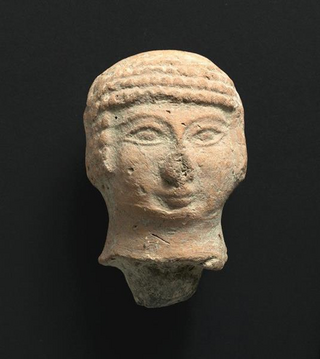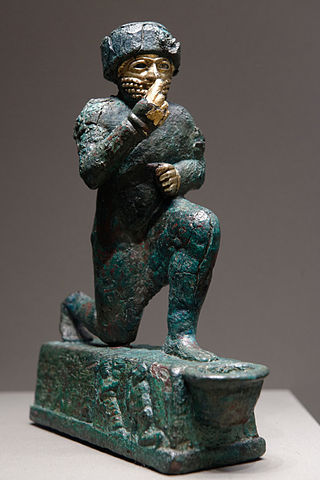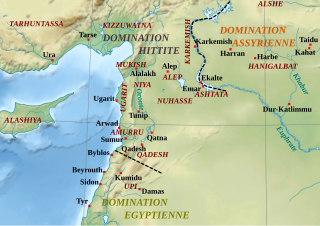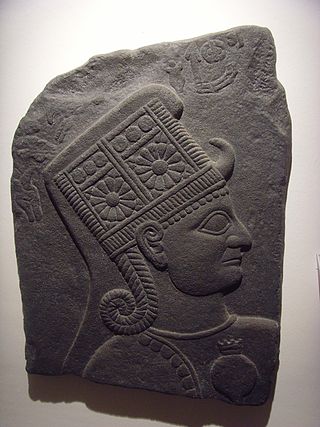
Asherah is the great goddess in ancient Semitic religion. She also appears in Hittite writings as Ašerdu(s) or Ašertu(s). Her name was Aṯeratum to the Amorites, and Athiratu in Ugarit. Some scholars hold that Yahweh and Asherah were a consort pair in ancient Israel and Judah, although others disagree.
A vassal state is any state that has a mutual obligation to a superior state or empire, in a status similar to that of a vassal in the feudal system in medieval Europe. Vassal states were common among the empires of the Near East, dating back to the era of the Egyptian, Hittite, and Mitanni conflict, as well as Ancient China.

Amurru, also known under the Sumerian name Martu, was a Mesopotamian god who served as the divine personification of the Amorites. In past scholarship it was often assumed that he originated as an Amorite deity, but today it is generally accepted that he developed as a divine stereotype of them in Mesopotamian religion. As such, he was associated with steppes and pastoralism, as evidenced by his epithets and iconography. While this was initially his only role, he gradually developed other functions, becoming known as a god of the mountains, a warlike weather deity and a divine exorcist.

Anat, Anatu, classically Anath was a goddess associated with warfare and hunting, best known from the Ugaritic texts. Most researchers assume that she originated in the Amorite culture of Bronze Age upper Mesopotamia, and that the goddess Ḫanat, attested in the texts from Mari and worshiped in a city sharing her name located in Suhum, should be considered her forerunner.

The Canaanite religion was the group of ancient Semitic religions practiced by the Canaanites living in the ancient Levant from at least the early Bronze Age to the first centuries CE. Canaanite religion was polytheistic and, in some cases, monolatristic.

Nikkal or Nikkal-wa-Ib was a goddess worshiped in various areas of the ancient Near East west of Mesopotamia. She was derived from the Mesopotamian goddess Ningal, and like her forerunner was regarded as the spouse of a moon god, whose precise identity varied between locations. While well attested in Hurrian and Hittite sources, as well as in Ugarit, she is largely absent from documents from the western part of ancient Syria.

Niqmaddu III was the seventh known ruler and king of Ugarit, an Ancient Syrian citystate in northwestern Syria, reigning from 1225 to 1220 BC, succeeding king Ibiranu. He took his name from the earlier Amorite ruler Niqmaddu, meaning "Addu has vindicated" to strengthen the supposed origins of his Ugaritic dynasty in the Amorites.
Ammittamru I was a king of the ancient Syrian city of Ugarit who ruled c. 1350 BC.

Niqmaddu II was the second ruler and king of Ugarit, an ancient Syrian citystate in northwestern Syria, reigning c. 1350–1315 BC and succeeding his less known father, Ammittamru I. He took his name from the earlier Amorite ruler Niqmaddu, meaning "Addu has vindicated" to strengthen the supposed Amorite origins of his Ugaritic dynasty.

Ar-Halba or was the third known ruler of Ugarit, an Ancient Syrian city state in northwestern Syria, reigning for no less than two years, possibly from 1315 to 1313 BC. He succeeded king Niqmaddu II.

Niqmepa was the fifth-from-last King of Ugarit, a city-state in northwestern Syria.

Nuhašše, was a region in northwestern Syria that flourished in the 2nd millennium BC. It was east of the Orontes River bordering Aleppo (northwest) and Qatna (south). It was a petty kingdom or federacy of principalities probably under a high king. Tell Khan Sheykhun has tenatively been identifed as kurnu-ḫa-šeki.
Shapshu or Shapsh, and also Shamshu, was a Canaanite sun goddess. She also served as the royal messenger of the high god El, her probable father. Her most common epithets in the Ugaritic corpus are nrt ỉlm špš, rbt špš, and špš ʿlm. In the pantheon lists KTU 1.118 and 1.148, Shapshu is equated with the Akkadian dšamaš.

Amurru was an Amorite kingdom established c. 2000 BC, in a region spanning present-day Northern Lebanon and north-western Syria.
Ahatmilku was a princess of Amurru, who became queen of Ugarit through marriage.

The Amorites were an ancient Northwest Semitic-speaking Bronze Age people from the Levant. Initially appearing in Sumerian records c. 2500 BC, they expanded and ruled most of the Levant, Mesopotamia and parts of Egypt from the 21st century BC to the late 17th century BC.
Adad-Nirari or Addu-Nirari was a king of Nuhašše in the 14th century BC. His identity and succession order is debated as well as the extent of his kingdom which might have included Qatna. Adad-Nirari engaged in a military struggle again the Hittite king Šuppiluliuma I, asking Egypt for help and invading the kingdom of Ugarit, a Hittite vassal. Those actions prompted Šuppiluliuma to invade the region and relive Ugarit. Adad-Nirari's fate is unknown as he disappeared from records.

Kubaba was a goddess of uncertain origin worshiped in ancient Syria. Despite the similarity of her name to these of legendary queen Kubaba of Kish and Phrygian Cybele, she is considered a distinct figure from them both. Her character is poorly known. Multiple local traditions associating her with other deities existed, and they cannot necessarily be harmonized with each other. She is first documented in texts from Kanesh and Alalakh, though her main cult center was Carchemish. She was among the deities worshiped in northern Syria who were incorporated into Hurrian religion, and in Hurrian context she occurs in some of the Ugaritic texts. She was also incorporated into Hittite religion through Hurrian intermediaties. In the first millennium BCE she was worshiped by Luwians, Arameans and Lydians, and references to her can be found in a number of Greek texts.
Milku was a god associated with the underworld who was worshiped in the kingdoms of Ugarit and Amurru in the late Bronze Age. It is possible that he originated further south, as Ugaritic texts indicate he was worshiped in cities located in the northern part of the Transjordan region. He was also incorporated into the Hurrian pantheon under the name Milkunni. There is also evidence that he was worshiped in Hittite religion. It is possible that a closely related deity is also known from Mesopotamia.












